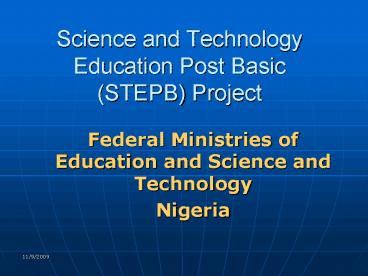Science and Technology Education Post Basic STEPB Project - PowerPoint PPT Presentation
1 / 18
Title:
Science and Technology Education Post Basic STEPB Project
Description:
6 STEPB study area reports and synthesis report: S&T strategy and ... FME and WB Joint-Study Guides. STEPB Project Design. b a c k. n e x t. h o m e. 9/1/09 ... – PowerPoint PPT presentation
Number of Views:23
Avg rating:3.0/5.0
Title: Science and Technology Education Post Basic STEPB Project
1
Science and Technology Education Post Basic
(STEPB) Project
- Federal Ministries of Education and Science and
Technology - Nigeria
2
STEPB Project Objective
- More and better qualified ST graduates
- Higher quality and more relevant research in
Nigeria - Area of focus federal Post-Basic ST and
Education Institutions (PBEIs)
3
STEPB Project Vision
- Increases in trained human resources
- Improvements in quality
- Improvements in teaching and learning of ST
- Improved relevance research, teaching, and
learning - Capacity enhancements of PBEIs (towards
international standards) - through catalytic, merit-based funding
4
Why STEPB?
- ST critical for Nigerias economic and social
development
To enhance rapid industrial growth and
efficient exploitation of resources, government
will encourage the development of strong
linkages between industries in the science and
technology parks, research and development
institutions, and university researchers.
--NEEDS 2004
5
Global appreciation for STs role in development
- International ST drives economic development
- Several types of WB support to ST across the
regions - Country-level interventions
- Sector Studies and Policy Dialogue
- Lending and Grants
- Global-level interventions
- Partnership and Grants
6
Nigerias STEPB project
- Science Technology Education in Post-Basic
(STEPB) project challenge - Support post-basic education and research at SSS,
universities, polytechnics, teacher training
colleges, and partners institutions (firms, NGOs,
public research institutes, etc.) in ST - Grant resources
- US180m US20 m
7
STEPB at a critical moment for Nigeria
- Exploding university enrollment
- Large youth population
- Emphasis on economic growth
- Potential to leverage areas of strength in ST
- Political commitment to ST for Nigerias growth
(e.g., AIST)
8
FME and WB Joint-Study Guides STEPB Project
Design
- Participative approach with diverse stakeholders
- 6 STEPB study area reports and synthesis report
- ST strategy and post-basic education
- STEPB issues cost financing
- Quality and relevance of learning and teaching in
ST areas - Distance learning and ICT
- Labor market demand and employment in ST areas
9
STEPB Project Structure
- 3 Components
- Differ by focus
- Research and technology development
- ST teaching and learning
- Centers of Excellence
- System-wide reforms
- Administration
- Environmentally responsible
10
STEPB Beneficiaries
- NUC (Universities)
- NBTE (Polytechnics)
- NCCE (Colleges of Education)
- FME ( FSTC/SSS)
- FMST (Research Institutes)
- SSS/FTC
- Partners of PBEIs (private sector, NGOs,
international ST partners, etc.)
11
Component 1 Quality and Enhancement and
Innovation Fund
- 4 categories for support through
competitive-based grant awards - 45 of STEPB Project resources
- Description
- Institutional research grants (up to US
250,000) - Partnership research grants (up to US 800,000)
- Innovator grants for young graduates (up to US
20,000) - Learning and teaching grants (up to US 3
million)
12
Component 2 Supporting the Emergence of Centers
of Excellence
- 30 of STEPB Project resources
- 7-9 Centers selected
- Emphasize integration of teaching and research,
linkages with private sector, and international
collaborations - Grants for emerging Centers of Excellence (up to
US 7 million)
13
Component 3 Supporting the Sector-wide
Initiatives and Project Management
- 15 of STEPB Project resources
- Description
- Institutional grants for policy and planning and
institutional strengthening (examples) - Developing national teaching standards for
science teaching - Reforming ST curricula
- Programs to attract more girls into ST
disciplines - Supporting STEPB Project management
14
Implementation Structure
15
National Project Steering Committee (NPSC)
- 12-18 members from FME, FMST, various ST
stakeholders and private ST sector - Function Strategic oversight
- Policy guidance
- Facilitate coordination between Ministries and
stakeholders - Oversee implementation
- Articulates national priorities and Government
policies
16
Implementation Structures (TRC, IAB, NPS)
- TRC Peer review (NG Intl)
- IAB Distinguished experts (Intl reputation)
- NPS Daily implementation
- PBEIs Grantees
- Stakeholder participation and transparency to
ensure accountability
17
Results through Partnership and Ownership
- Project duration 4 years
- Sustainability and transparency longer term
program required - Partners
- Institutional (TRC and IAB)
- Government and private sector
- Development partners
18
Thank you!www.stepbnigeria.net
- NATIONAL PROJECT COORDINATOR
- Prof. M. Daniyan
- Email npc_stepb_at_yahoo.co.uk or
- madaniyan_at_yahoo.co.uk































